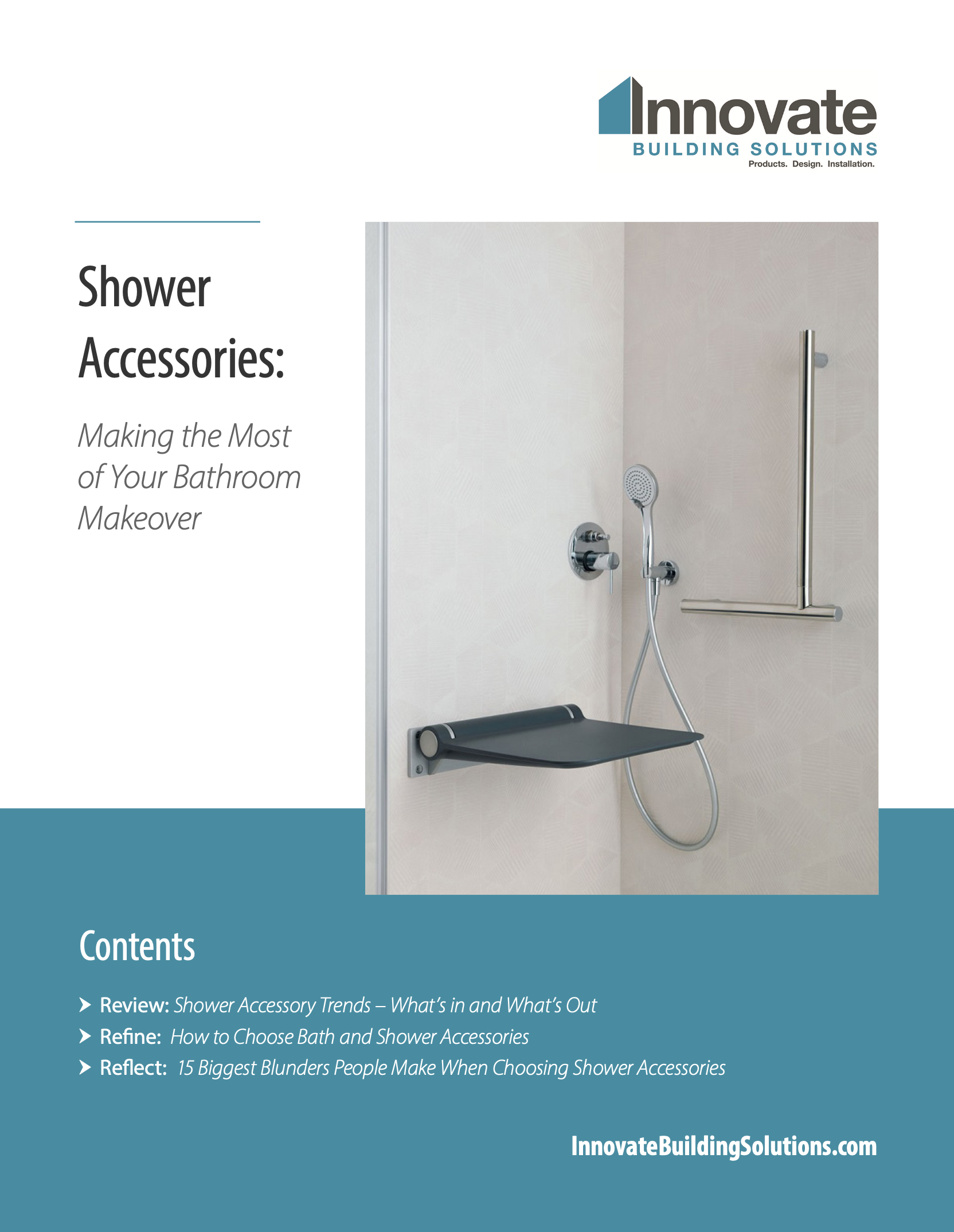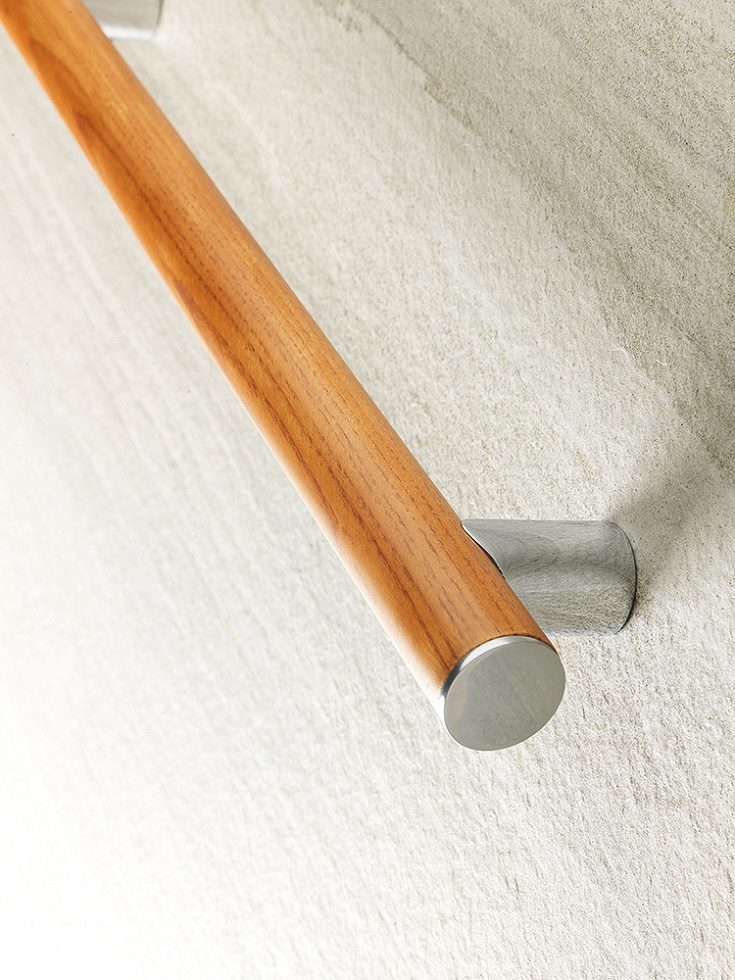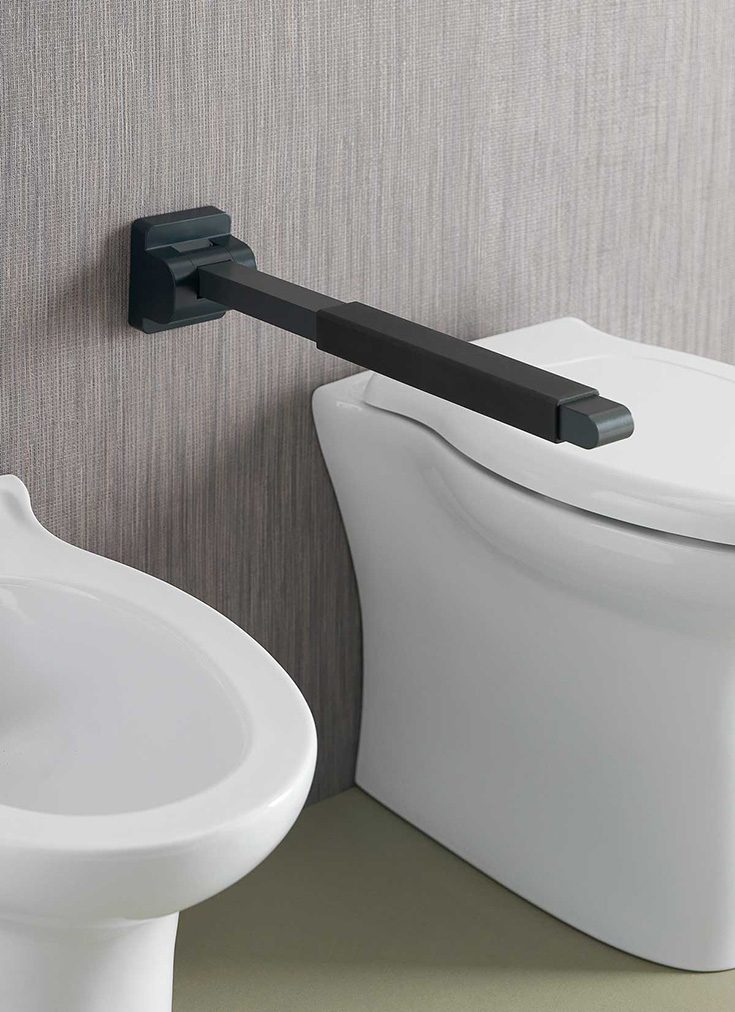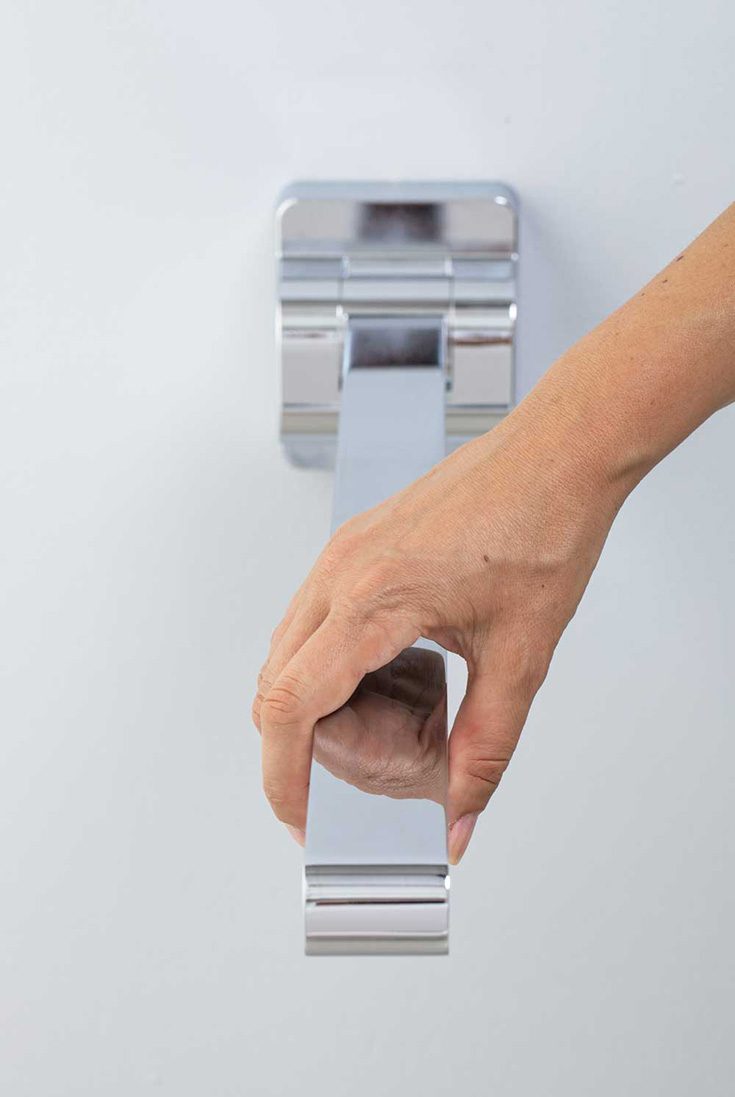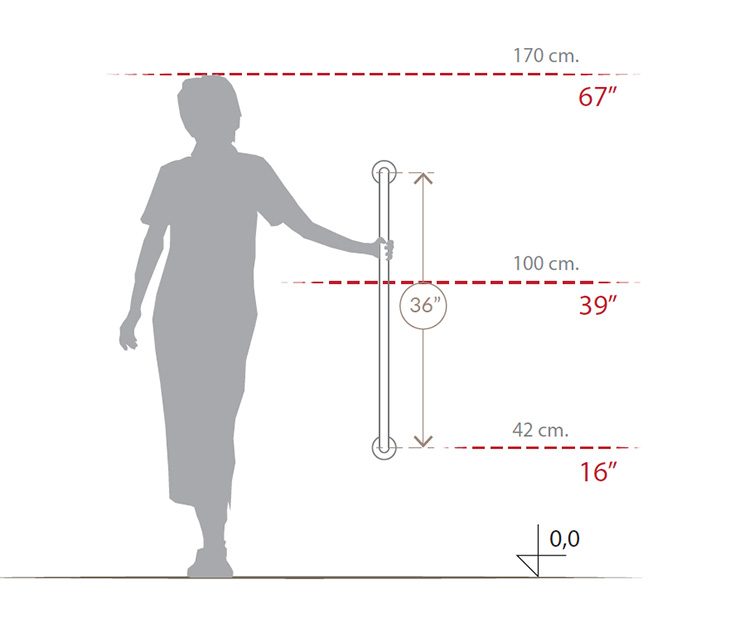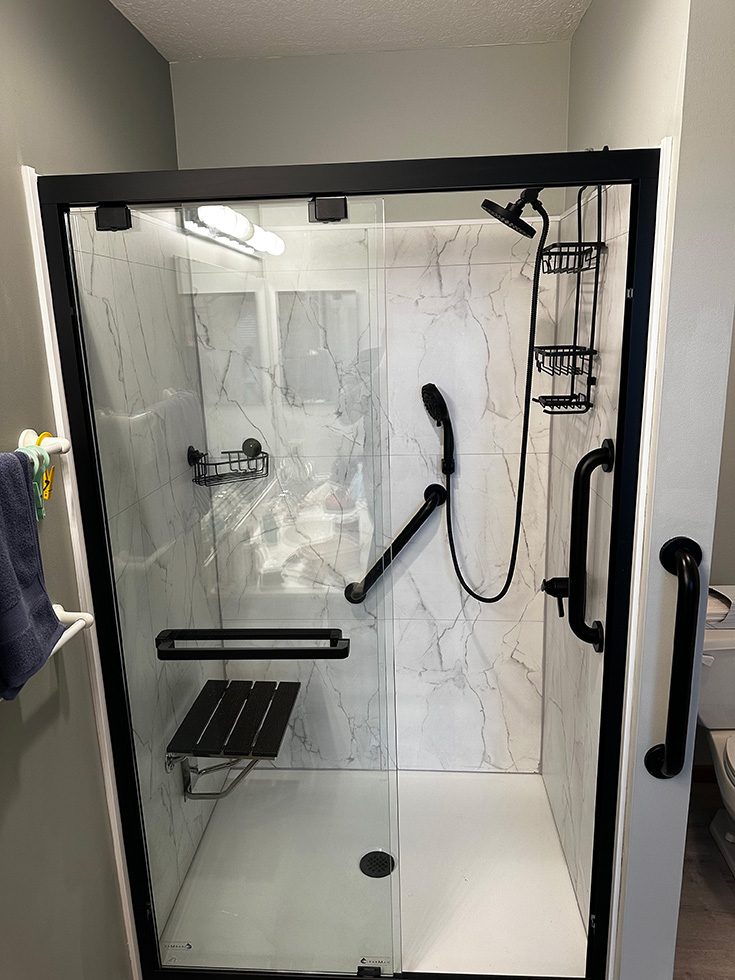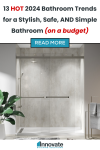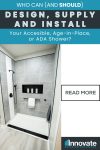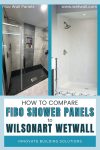Frequently Asked Questions about Grab Bars in a Bathroom …a Product Everyone Loves to HATE!
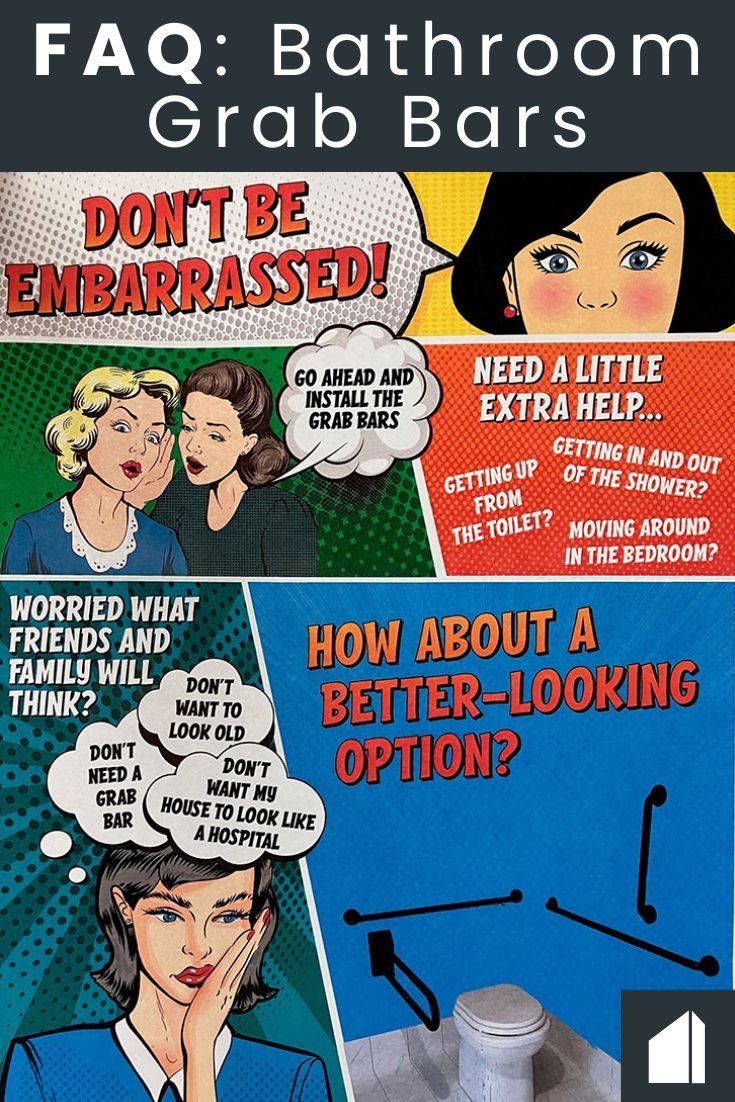
I’m coming clean (no bathroom pun intended) right up front. While I lead a business which sell grab bars, for many years I ‘took orders for’ grab bars. And by that I mean, I wasn’t too knowledgeable. I simply asked people what they wanted. I didn’t ask probing questions to guide them to what they really needed. I didn’t help people on where they should go, or what direction they should be mounted in.
And why might that be, you may be asking?
Well for one as a 65 year old guy (who swears he DOES NOT look a day over 64!), I found the topic of grab bars depressing. Let’s be real. Who really wants an ugly safety accessory in their bathtub or shower if they don’t need one?
Who doesn’t want to install a grab bar because they’ll be embarrassed to have one?
The bottom line is….grab bars are a product PEOPLE LOVE TO HATE!
And another reason I took orders for grab bars is because they’re far from the ‘sexiest,’ or highest value parts of the bathroom. The ‘action’ (or larger sales) are shower pans, shower wall surrounds, and glass doors. Basically, grab bars are the Rodney Dangerfield part of a bathroom. “They get no respect!”
Of course they get no respect, or little respect, until AFTER they’re needed or a family member falls which could have been stopped, or the severity of the injury lessened.
And while I’ll admit grab bars aren’t sexy, it’s nice to know there are styles and options today which DO look cool AND provide safety. And some grab bars even have functions beyond that. And that’s a Ripley’s Believe it Or Not statement if I ever heard one.
And so now that I have you ‘chompin’ at the bit’ to learn more (sarcasm intended), let me tell you three goals of this article about frequently asked questions about grab bars.
- Goal #1) As Sergeant Joe Friday on Dragnet used to say, one goal will be to give you “just the facts ma’am (or sir).’ I’ll explain what a grab bar is, why you should install one, sizes, materials available, and even info on how to properly mount one. Basic, mundane stuff.

- Goal #2) I’ll dispel half truths and ‘fake news’ (not be political) about grab bars and help you avoid the biggest mistakes with them. There’s a reason grab bars have been depressing to many people (including myself before I learned more). However, I’ll argue they’re a bathroom feature to be embraced, not avoided like the plague.
- Goal #3) I’ll provide resources to people and companies who not only sell grab bars but can guide to you the best size for your project and where you should put them in your bathroom.
So – let’s dig in.
Frequently asked question #1 about grab bars in a bathroom– “What is a grab bar?”
A grab bar’s purpose is to improve safety by providing additional support and stability for people with mobility or balance issues, or who have disabilities. However, in addition, grab bars can also offer places for storing soap, shampoo bottles, hanging towels or grab bars can even brighten a space with additional lighting.
Frequently asked question #2 about grab bars in a bathroom– “Do I really need a grab bar, because I really don’t want one?”
Most people HATE, HATE, HATE grab bars because of the ugly commercial ones they see in hospitals or truck stops. Can you say YUCK!
And this is where G.B.R. comes in (and for those of you ‘playing at home,’ that’s ‘Grab Bar Resistance.)’ And commercial grab bars offer a ‘look’ (if you can call it that) most people want to avoid at all costs.
However, as you’ll see later grab bars don’t need to be the ‘ugly stepchildren’ in the bathroom. And they can be especially important to plan for now even if YOU don’t need one at this time. By installing ‘blocking’ (‘err thick wood behind the wall) you’ll be able to add grab bars, fold down seats etc. at any point without compromising safety and lessen the costs of adding them later.
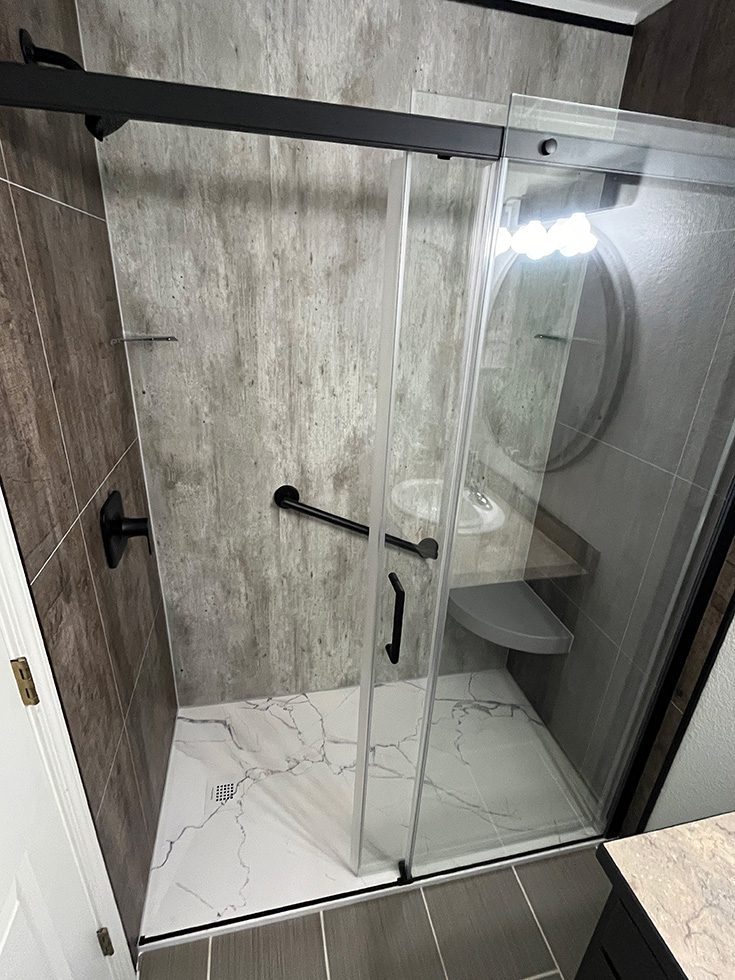
For example, a grab bar can make your home more visitable for family and friends of all ages and abilities.
A grab bar can also allow people to stay independent in their own homes. And many people don’t realize (until they need to do the research) average assisted living facilities cost $5,000 per month! And that’s NOT chump change! If you can avoid assisted living you’ll save a lot of money….and can continue to eat what you want (not what’s on the community facility menu).
In addition, grab bars reduce falls by 30%. And since one in four people over 65 fall each year (and falls cause more deaths than cancer) fall prevention in the form of a low-cost grab bar is a smart investment.
Frequently asked question #3 about grab bars in a bathroom – “What’s the material cost of a grab bar and the labor costs to install one?”
Grab bar prices vary greatly depending on the material used, thickness and length of the bar – and whether it’s installed or not.
The cheapest grab bars are plastic. I wouldn’t touch these (or grab these) with a 10’ pole! The most commonly used bars are made of stainless steel. In addition, you can even find luxury grab bars made of exotic varieties of wood. Safety can be cool.
The plastic grab bars are as cheap as $20. Better quality grab bars are $100 to $300 (depending on size).
Grab bar installations can range from $100 to $300 depending on the number you’re installing, and the wall type they’re going into.
Also grab bars are a far cheaper ‘insurance policy’ than spending money on an Allstate homeowners insurance policy – although they’re certainly NOT as funny as their ‘Mayhem’ commercials (and I hope you enjoy the one below for a laugh).
Frequently asked question #4 about grab bars in a bathroom – “What’s the biggest mistakes to avoid in buying and/or installing a grab bar(s)?”
While anyone – from a DIY’er to a handyman to a professional bathroom remodeling contractor should be able to install a grab bar – this DOES NOT mean everyone has the knowledge to buy the right size (and type of) grab bar and/or to install it properly. However, here’s a few of the biggest mistakes you’ll want to avoid.
- Buying a support bar which installs with suction cups. This is an accident (literally) waiting to happen. Don’t go ‘uber-cheap’ with a suction cup support bar. They’ll give you (and others using your shower) a false sense of security. This may be worse than no security at all.
- Installing a grab bar on an angle. If you’re falling a grab bar in the horizontal or vertical position will provide more stability to keep you upright than the same grab bars angled on the wall. Occupational Therapists report that angled grab bars allow you to slide down during a fall.
-
- Buying an ugly, institutional-looking grab bar. Why hurt the looks of your bathroom and/or make it harder to sell your home down the road. Since grab bars aren’t too expensive, it’s simple to avoid the ‘hospital/truck stop looking grab bar’ we’ve all come to hate!
Frequently asked question #5 about grab bars in a bathroom – “What is the best location for grab bars in a shower or tub? Should shower grab bar placement be vertical, horizontal, or on an angle?”
Since more falls occur in bathrooms (because it’s a wet and slippery space) than in any other room in the house, it’s logical there’s a number of places owners (and visitors) find grab bars helpful. Here’s the top places – in order of priority where grab bars are recommended for your bathroom:
- Priority #1 – At the tub or shower entrance – Since the #1 place for falls is as you get in or get out of a tub or shower – if you could only afford one grab bar this is where you should install one first. Install the grab bar vertically into a stud near the entrance.
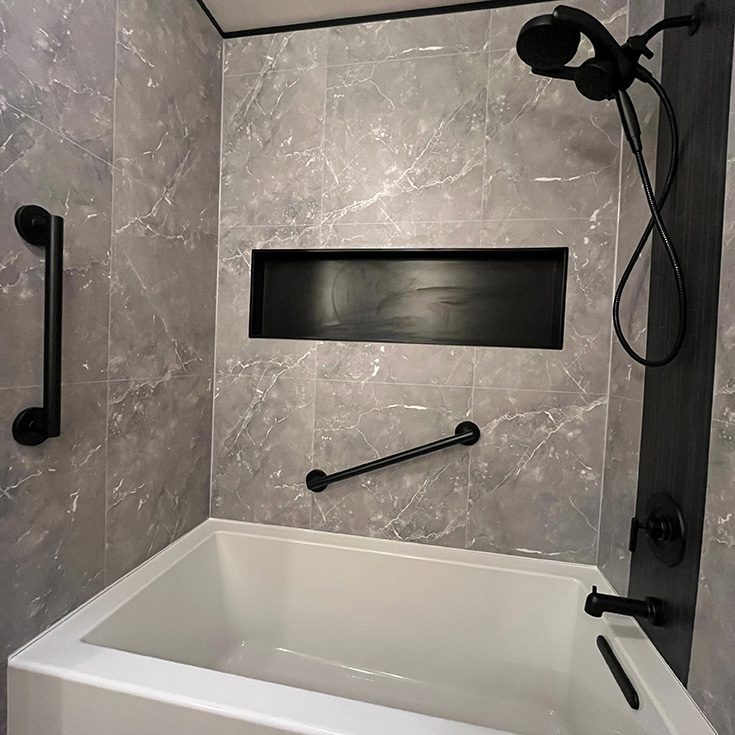
- Priority #2 – Inside the shower on the long back wall. Most alcove shower (those with 3 interior wall surrounds) have a long back wall, and smaller walls on the left or right sides. A horizontal grab bar should be put where you’ll be standing while showering on the long back wall. Some people also like to set this bar at an angle so it can be grabbed at different heights.
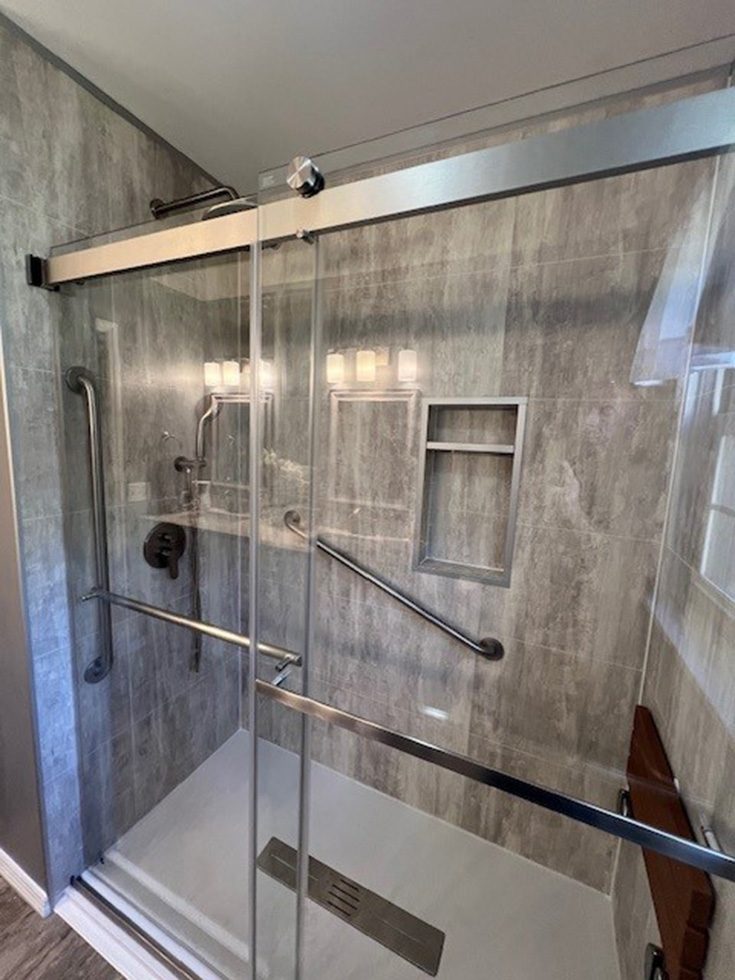
- Priority #3 – Close to the toilet – Getting up from a toilet (especially if you don’t have a comfort height toilet) can be difficult if you have mobility challenges. In these instances you can install a fixed grab bar or a fold down grab bar by the toilet in a horizontal orientation.
- Priority #4 – By the sink – For additional stability it can be nice to have a horizontal or vertical grab bar close to the sink. A grab bar can also be installed and used as a towel bar.
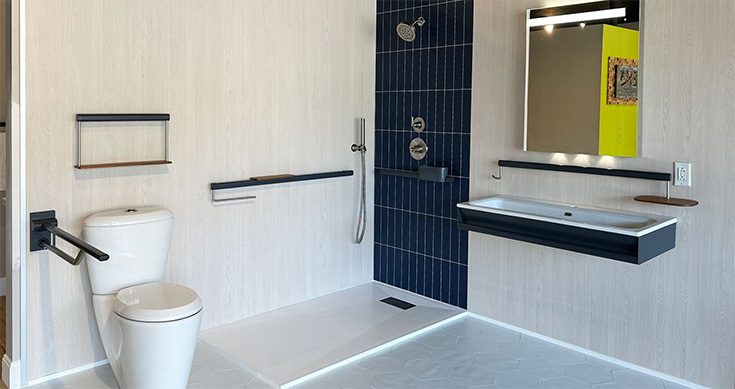
Frequently asked question #6 about grab bars in a bathroom – “What types of grab bars are available and where should they be used?”
Most people are familiar with the straight grab which is anchored to the wall. It’s versatile and can be used almost any place in the bathroom.
However, few people have seen ‘fold down grab bars.’ This type of bar saves space and can be used close to a toilet, vanity, or glass shower wall where there isn’t a framed wall where you can anchor a ‘standard grab bar.’ Folding grab bars an also be placed in a shower on the open side of the shower seat.
Another variation on the grab bar is the compact ‘grab bar/toilet paper holder.’ It’s used by the toilet. That’s a ‘BOGO’ special because you can get two functions for the price of one (a T.P. holder and a grab bar) … AND saves space vs. two separate products.
Or another option is the ‘grab shelf.’ This is used inside the shower to house soap, shampoo and conditioner bottles AND serves as a safety grab bar. Again, it’s another BOGO (buy one function, get another function for free) grab bar.
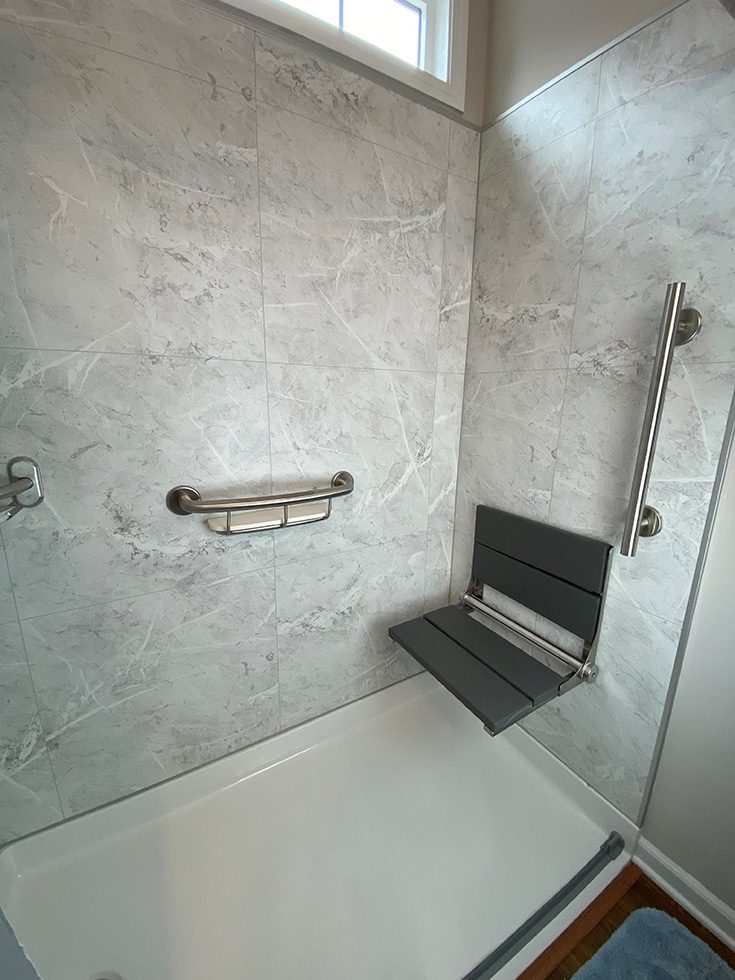
Frequently asked question #7 about grab bars in a bathroom – “What grab bar sizes are available? Where should I install grab bars in a bathroom?”
Grab bars are available in many widths, shapes, and thicknesses.
You can get grab bars in 12”, 16”, 18”, 24”, 30”, 32”, 36”, 42”, and even 48” widths. The ‘load capacity’ of shorter grab bars are generally larger than longer grab bars. For example, in the high quality Ponte Giulio grab bars the 12” to 32” grab bars have a 450 pound capacity, whereas the longer grab bars (from 36” to 48”) have a 265 pound capacity.
The diameter of grab bars (and even those which are ADA approved) are generally 1 ¼” and 1 ½” wide and the surface should be non-slip. However, please note the 1 ½” thick bars can be hard for those with smaller hands to grip.
Grab bars along a ‘back wall’ of a shower are often 24” wide and mounted horizontally.
At the entrance (where the grab should be vertically installed) you can use smaller – 12” to 18”, or tall grab bars 42” to 48” high. You may be asking why so much variation, and which one would be best to use?
Well, taller grab bars at the entrance can make a lot of sense because they can be installed closer to the floor (than the short bars) and can help someone who has fallen to grab onto the tall bar to get back up. And as Becky Wright, Division Manager of Ponte Giulio USA (a high quality grab bar manufacturer) told me, “Mike, longer vertical bars also assist homeowners and their guests, including smaller (or shorter) grandchildren get in and out of the shower safely.”
Another thing to pay attention to when buying a grab bar, beyond their size and thickness, is whether you’re installing them into an existing shower surround (where nothing else is being removed) or into a newly remodeled, or new construction space.
With an existing space (where nothing is being removed) you may want to get a bar which can be installed directly into the studs. And since studs are generally 16” apart if the bar is being installed horizontally, you’ll want to buy a bar which is 16” or 32” so it can be anchored to the studs.
In a newly remodeled space – you can install backer board (AKA blocking) and have far more flexibility on where to put the grab bar, and what size to use down the road.
Frequently asked question #8 about grab bars in a bathroom – “Do I need an ADA grab bar? And what are the ADA grab bar requirements?
Many people will ask for an ‘ADA shower’ or an ‘ADA grab bar’ without really understanding what ADA is and if they even need it.
Basically – ADA is an acronym for the Americans with Disability Act. An ADA grab bar (or shower) is only required in public buildings. So, if this is for your private home it’s not a requirement you need to be concerned with.
However, you’ll find many better grab bars – for safety – do meet the ADA requirements which require the bar be 1 ¼” or 1 ½” thick and have at least 250 pounds of weight capacity with no more than 1 ½” of open space between the inside of the grab bar and the wall (so your arm can’t slide down and get stuck).
Frequently asked question #9 about grab bars in a bathroom – “How should I choose the best color/finish?
Fortunately – grab bars are no longer simply an institutional looking, ‘one size fits all’ proposition! And the fact that there’s stylish grab bars is a reason to celebrate them so you no longer have to be depressed adding them to your design.
However, while better quality – and better looking – grab bar choices are a good thing, it doesn’t mean it’ll make your selections simpler. The question is what criterion should you use in selecting the best color/finish for your projects? Here’s 3 things to consider:
- Will the grab bars match other fixtures? Generally, if you’re using a chrome, brushed nickel, matte black, or brushed brass finish in your shower heads and/or shower doors – it’s preferred to use the same finish for your grab bars.
-
- Will they contrast the shower wall surrounds? If you’re like me – and your eyes aren’t what they used to be, it’s smart to use a contrasting color or finish for your grab bar to the wall surrounds so you can see them clearly if you need to quickly reach for the bar for balance. Vinyl coated grab bars come in 11 colors, so if contrast is needed they can be a great option (especially if you want fun color grab bars for a kids bathroom!).
- Will the grab bar be easy to clean? Polished finishes (like polished chrome and polished brass) show spotting easily. And if you’re O.C.D. and hate spots –choose brushed nickel, matte black, or matte brass.
Frequently asked question #10 about grab bars in a bathroom – “Who can help me select and/or install grab bars at my home?
If bathroom remodeling (or doing a bathroom modification for an elderly parent or ‘differently-abled’ child) are blowing your mind, I get it.
Sometimes the smartest thing you can do is find a reputable contractor or health care professional to not only help you select and install your grab bars – but also help with all the ‘moving parts’ of a bathroom remodel – or bathroom modification project. The question is who you gonna call? And I’d recommend it’s NOT Ghost Busters! However, if you’re not sure, here’s where to start:
- For full bathroom remodeling (with the inclusion of features like grab bars) look for a CAPS (Certified Aging In Place Contractor) or a specialized ‘home access contractor.’ CAPS certified contractors have a good understanding of accessible and age in place fundamentals. On the other hand – if you’re needing to have a bathroom designed (and built) for someone with a serious health condition, specialized home access contractors can help with anything related to accessibility. And there’s even a group called VGM Live at Home to get referrals to home access contractors or call me at 877-668-5888 because I work with quite of few home access contractors across the country.
- For medical input, a licensed Occupational Therapist (O.T) or Physical Therapist (P.T.) can be quite helpful and also refer you to contractors to assist with the job. OT’s and PT’s are experts in grab bar usage and can customize placement for you.
OK – did I achieve my 3 goals of this article? What questions do you have about grab bars, or age in place or accessible remodeling?
If I did my job right, I’ve provided you with a deeper insights on grab bars than what would be regurgitated (a long word I threw in for you to think I’m smart…is it working?) through a ChatGPT query. Let me know if you ‘got your money’s worth! And if so, I can then send you a bill…ha! ha!
I lead a business which not only wholesales grab bars, accessible shower pans, stylish shower wall panels and door across the country, but we also install age in place or accessible bathrooms in the Northeast Ohio (Cleveland and Akron primarily) as well.
To learn more about grab bars, shower products, or find a qualified contractors to install your shower nationwide, call a Shower Specialist at Innovate Building Solutions at 877-668-5888 or click for a Free Design Consultation. And for a Cleveland shower remodeling contractor call 216-531-6085.
I know there’s a lot of decisions in remodeling your bathroom, or choosing just the right products for bathrooms in a new home. And if there’s one thing me and my team would love to do is make this process simpler for you.
Thanks for reading and putting up with my wacky personality along the way.
Mike
